Bovines have been a part of human life for thousands of years. The ancestors of cattle and bison, named aurochs, can be seen on paintings of cave walls in Europe. We have used bovines for centuries to pull plows, for their hides, for milk and cheese, and their flesh for food. It is a safe bet that it didn’t take early humans long to determine that different muscles in the carcass had different characteristics. Some were tender, some tough, some juicy, some fatty, some rich in flavor, and some bland. But how do you learn about all of the different beef cuts? How do you know which cut will work for you?
The beef making process
Nowadays most steers and heifers live on farms eating grass and hay until they are about 15 months of age. Then they are sold to huge feed lots where they stay for about four months and are fed grain, mostly a type of high-calorie corn flake, and vitamins and medicines, often including antibiotics, for about four months. According to Amazingibs.com’s beef scientist, Dr. Antonio Mata, “Bovines are like humans. When they consume a lot of calories they accumulate fat. First belly fat, then subcutaneous fat, then fat between the muscles, and finally intramuscular fat, which is marbling. The process is very inefficient but produces huge quantities of tasty beef at relatively low cost.”
On the other hand, the process has come under a great deal of criticism for a number of issues including arguments that the method is inhumane; that the antibiotics are not killing all the bacteria and the ones that survive are antibiotic resistant, and that means that humans can no longer rely on antibiotics when they get sick; that corn subsidies are making beef artificially cheap; that these large Concentrated Animal Feeding Operations (CAFOs) create a massive environmental hazard with unmanageable quantities of waste chief among them.
More and more cattle are being finished on farms on grass rather than grain, where the manure fertilizes the grass they eventually eat. The resulting meat is more expensive, often chewier, and tastes different, with a mineral character that I remember from my youth, before CAFOs.
How does it taste?
Some disdain the taste, some love it. Mata says “grasses vary greatly. Alfalfa hay for example, can produce beef with plenty of marbling and superb flavor. Some of the best beef I’ve tasted has been fed primarily alfalfa. On the other hand, winter grasses produce beef with limited amount of marbling and depending on the grass, sometimes there is a fish-like flavor. Just like beef cuts, not all grasses are created equal, and most produce marginal tasting beef.”
I love the taste of both grass finished and corn finished meats. For more on the subject, read my article on beef grades. I hope to discuss these political and economic issues in depth in the future. Suffice it to say that I have read extensively on the subject, and I agree that corn subsidies, CAFOs, and antibiotic overuse are serious issues and there may be viable alternatives, but the impact of these other systems will certainly mean more expensive beef. Many of us can afford pricier beef, but many, especially those who depend on cheap ground beef, would face hardship or a major lifestyle change.
Beef primals & the cuts they contain
For centuries, animals were slaughtered and broken down by the town butcher and by restaurants close to where they were grown, and there was no label consistency from one butcher to the next. In 1865, immediately after the Civil War, the Union Stockyards in Chicago became a central distribution point for shipping live animals. In 1880 Gustavus Swift, a large meat processor, introduced a rail car that was well insulated, cooled by ice, and designed so that the shifting weight of hanging sides and quarters would not derail the car. The cold meat could stay fresh for days and be distributed to remote locations, like Miami, where they would be broken down by local butchers and restaurants. But the cuts and labels were still inconsistent.
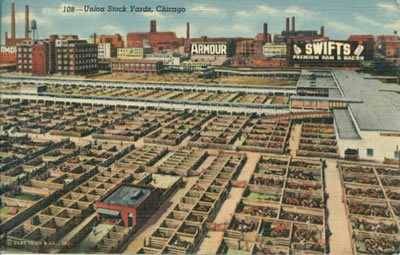
This changed in War World II when the government standardized on “primal cuts” and corresponding nomenclature. There were seven primals: Chuck, rib, loin, round, short plate, shank and brisket, and flank. Some of these primal were further segmented into sub-primals: The loin is comprised of the short loin and the sirloin sub-primals.
In the 1960s a major change was pioneered by Iowa Beef Processors, called “boxed beef”. They removed many bones and a significant amount of fat at the slaughterhouse, then placed the cuts in sterile shrink wrapped plastic bags without oxygen, and packed them in boxes of the same cut. Without oxygen and chilled or frozen, the meat was safe from microbial spoilage and oxidation. Pork and other meat packers followed shortly.
About different beef cuts
Butchers long ago began excavating the carcass and named the cuts of meat, muscles, and groups of muscles they discovered. The jargon is confusing. There are more than 50 common cuts in the US, and some go by multiple names. Some have been confused for so long that nobody can say for sure what a Delmonico or London broil really are. To add to the confusion, the cuts and names are different around the world, even in English speaking countries. Today the North American Meat Processors book, The NAMP Meat Buyer’s Guide has become the standard by which butchers cut their meats so a chuck roll is the same coast to coast (see sidebar). It is the definitive argument ender.
In April 2013 The Beef Checkoff Program, the National Pork Board, and the United States Department of Agriculture (USDA) agreed to new labeling standards in an attempt to “make things easier on the consumer”. In many cases it has made things more confusing. Click here to see a pdf of all the new beef names and the old ones side by side. The old names are in the right column. I have highlighted some of the more interesting changes. New names are included below.
In general the cuts that come off the primals can be classified as (1) roasts, which are large thick muscle groups that can feed at least four people, (2) steaks, individual servings that are flat and perfect for grilling, (3) stew meat, chunks cut from odd shaped pieces, and (4) ground meat or hamburger, from scraps. Enjoy this visual guide to the various cuts of beef:
New cuts
Meat scientists like the AmazingRibs.com consultant Dr. Antonio Mata have been busy digging around in the bovine carcass for decades in search of muscles and groups of muscles that deliver pleasure and profit. In 2012 Mata created and trademarked the Las Vegas Strip Steak (TM), shown here, from a muscle buried deep in the shoulder. It has a complex steely flavor, plenty of juice, and starts thin but plumps when grilled.
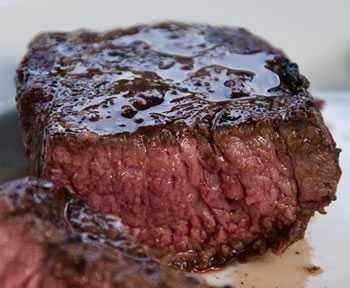
In the past few years he and his peers have created these newcomers, among others: Flat Iron, Petite Tender, Rib Cap, Denver Steak, Ranch Steak, Merlot Cut, Sierra Cut, Santa Fe Cut, Tucson Cut, San Antonio Cut, Round Petite Tender, Braison, Western Griller, Western Tip, and the Flat Triangle. Restaurants are seeking a leg up on the competition by featuring these new cuts.
In the past decade bison has taken off. The meat is similar to beef in flavor, but the muscles tend to have less intramuscular marbling, making them big and bold in flavor and lower in calories. I have tasted and enjoyed a number of cuts from High Plains Bison. I have also tasted other bison that had gamey flavors. Fascinating, but different from grocery store beef.
Below are the most important beef cuts in the US, from a popularity and quality standpoint, and further down is a gallery of photos. The bold names are called “primal cuts” and I have added important subcuts in italics. I will be updating it with the new info shortly. For highly technical interactive dissection of a bovine, visit the University of Nebraska Bovine Myology pages.
Tenderness or flavor?
When shopping for meat, the muscles that have the most marbling, the most flecks of fat mixed in with the muscle fibers, are the most flavorful. Often the most tender, the muscles that don’t work a lot, are the most tender. For example, the tenderloin is the most tender cut, and among the most expensive, but it is not the most tasty because it is very lean. Often the harder working muscles are more flavorful, but they are tougher. You can combat the chewiness by proper cooking, usually by reverse sear.
Rib primal or ribeye (about 10% of the meat)
Here’s where the best meat on the steer is found. And the most expensive. The main muscle is the loin muscle, or the longissimus dorsi which runs from between the 2nd and 3rd rib from within the chuck (shoulder) all the way through the sirloin to the hip bone. It is the longest muscle on the animal. There is one on either side of the spine.
The rib primal begins between the 5th and 6th rib and ends between the 12th and 13th rib. Well marbled ribeye steaks are the first choice of connoisseurs, prime rib roast is the ultimate feast for friends and family, and the little known rib cap, the spinalis dorsi, is the best muscle on the animal. These cuts have a perfect balance of muscle and intramuscular fat to produce optimal flavor and juiciness.
Beef ribs come in two sections, the curved back ribs from near the spine, and the straighter, meatier short ribs, from the side, which start here and continue into the short plate and even into the chuck.
Roasts
- Prime rib roast
Steaks
- Ribeye steak
- Cowboy ribeye steak
- Eye of ribeye steak
- Rib cap steak
Other
- Back ribs
- Short ribs
- Spareribs
Loin (Short Loin & Sirloin 17%)
Here’s a section that can challenge the rib primal for primacy when cooked properly. Again, the main muscle is the longissimus dorsi muscle. The longissimus has many popular names in the loin section: Strip steak, New York strip, Kansas City strip, shell steak, loin, and strip loin.
The other main muscle in this primal is the tenderloin, or psoas major. This is the muscle from which filet mignon and chateaubriand is cut.
Strip is marbled and mouth coating, tenderloin has little fat and is the most tender muscle on the steer. Delightfully, the two come together in T-bone and porterhouse steaks.
The T-bone and porterhouse are similar looking steaks with the two muscles separated by a T-shaped section of backbone. One side of the T has a large section of loin and the other has a small section of tenderloin. The difference between the porterhouse and T-bone is the size of tenderloin. Because the tenderloin tapers like a baseball bat and the T-bone is further to the front of the animal, the tenderloin portion is smaller than on the porterhouse, a minimum of 1/2″ wide at the T. The tenderloin on the porterhouse must be a minimum of 1 1/4″ wide, but they can be up to 3″ wide as you move to the rear.
Sometimes tenderloin/filets are left on the T-shaped bone, sometimes they are removed. Ditto for the loin. Interestingly, porterhouse is getting hard to find because the animals are getting so big that a 1″ steak can weigh a whopping 25 ounces.
Tri-tip is the poor man’s tenderloin, and strip loin roasts can be just as good as prime ribs.
Roasts
- Strip loin roast
- Tenderloin roast
- Chateaubriand roast
- Tri-tip roast
- Ball tip roast
- Top sirloin roast
- Top sirloin butt roast
- Coulotte roast
- Petite sirloin roast
Steaks
- Strip steak
- T-bone steak
- Porterhouse steak
- Sirloin steaks
- Coulotte (top sirloin) steak
- Filet of sirloin
- Hanger steak
- Petite sirloin steak
- Bavette steak
Other
- Bottom sirloin flap meat
- Stew meat
- Ground sirloin
- Tenderloin tips
- Flap
Round (23%)
The hind legs put in a lot of work pushing around 1000 pounds or so of beast and thus produce ornery cuts. There are some roasts that must be slow cooked and cut thin, plenty of stew meat, abundant hamburger, and a few steaks that beg for reverse searing: Start low and slow, and sear just before serving.
Roasts
- Rump roast
- Top inside round roast
- Bottom outside round roast
- Eye of round roast
- Knuckle (a.k.a. Sirloin Tip)
Steaks
- London Broil
- Eye of round steak
- Round steak
- Top round steak
- Merlot steak
- Western steak
Other
- Hind shank
- Stew meat
- Ground round
Chuck (30%)
The sturdy shoulder shoulders a great deal of weight and is a tangled mass of muscles, sinew, and fat. Many impressive roasts and steaks come from the chuck, fine stew meat, not to mention most of the best burgers. At the rear of the chuck, where it connects to the rib primal there are about two steaks called chuck eyes that are practically the same as the vaunted ribeye, only a lot cheaper.
Roasts
- Chuck roast
- Shoulder clod roast
- Chuck roll roast
- Chuck eye roast
- Petite tender roast
- Arm roast
- Denver roast
- Ranch roast
Steaks
- Chuck eye steak
- Petite tender steak
- Flat iron steak
- Top blade steak
- Ranch steak
- Denver cut steak
- Mock tender steaks
- Las Vegas strip steak
- Sierra steak
Other
- Ground chuck
- Stew meat
- Shoulder tender medallions
- Country style chuck ribs
- Chuck short ribs
Brisket (6%)
This boneless mass from the chest contains two major muscles, including the pectorals, a thick fat cap, and it is tough as nails unless cooked low and slow. That’s why it is braised in every Jewish household, or smoke roasted in every Texas barbecue joint. And on St. Patrick’s Day cured brisket, corned beef, is simmered with cabbage. Take a slab of corned beef, give it the right rub, smoke it, and you may have the most sublime taste on the steer: pastrami.
Roasts
- Whole packer brisket
- Brisket flat
- Brisket point
Short Plate (6%)
Rife with marbling and layers of fat, this is the meat on top of the rib bones on the side, tough but rich. If cooked gently for a long time, as in a braise of wine and spices, or in air filled with smoke, it turns into the ultimate comfort food. Chefs are discovering that there are some fancy burgers in there.
Steaks
- Skirt steak
- Hanger steak
Other
- Short plate
- Short ribs
Fore Shank (4%)
A gnarly and knotty knot of twisted muscles and tendons, this is meat best for long slow braises and for soups.
Other
- Foreshank
- Shank cross cut
Flank (4%)
Rich in beefy flavor, with a quick searing char, this flap of flavor is a poor man’s ribeye. But beware, it has long fibers that must be cut across the grain and thin to give up its goodness.
Steaks
- Flank steak
Offal & Other Cuts
Italians call these meats the “quinto quarto” the fifth quarter. Not popular in the US, they are very common in other countries.
- Heart
- Liver
- Kidneys
- Cheeks
- Tongue
- Brains
- Sweetbreads
- Tripe
- Stomach
- Ox tail
Tenderness
Meat scientists measure tenderness by using devices that measure the amount of force needed to shear the muscle. Here are the top ten “tender” and “tough” cuts in shear force from the National Beef Tenderness Survey. Shear force is shown as pounds of force to shear one-half-inch cores, removed parallel to the muscle fibers, of cooked muscle from steaks and roasts. Source: Morgan et al (1991).
Top 10 most tender
- Tenderloin steak 5.7
- Top blade steak 6.7
- Top loin steak 7.2
- Rib roast 7.3
- Rib steak 7.4
- Ribeye steak 7.5
- Chuck roll roast 7.6
- Clod roast 7.9
- Round tip roast 7.9
- Top sirloin steak 8.0
Top 10 Toughest
- Round tip steak 8.9
- Bottom round roast 8.9
- Chuck tender steak 9.0
- Top round roast 9.0
- Eye of round roast 9.2
- Chuck roll steak 9.2
- Rump roast 9.5
- Bottom round steak 9.7
- Eye of round steak 10.3
- Top round steak 11.7
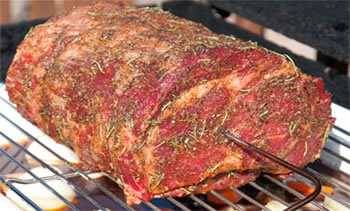
Boneless rib roast. Click for a recipe.
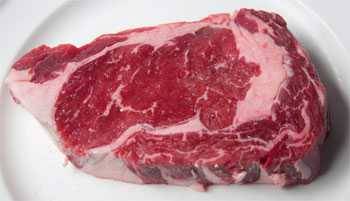
Boneless ribeye. Eye is in center, rib cap on the right and bottom.Click here for steak cooking tips.
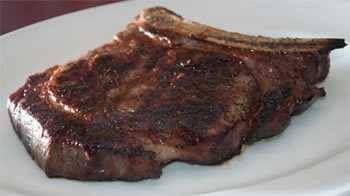
Bone-in ribeye. Click here for steak cooking tips.

Eye of ribeye.
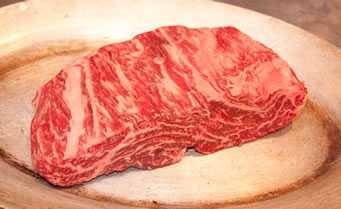
Rib cap from American Wagyu beef.
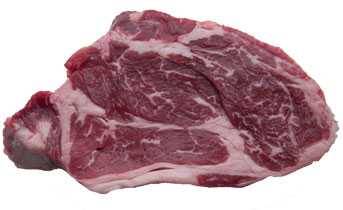
Chuck-eye. Click here for more about the various cuts of chuck steaks.
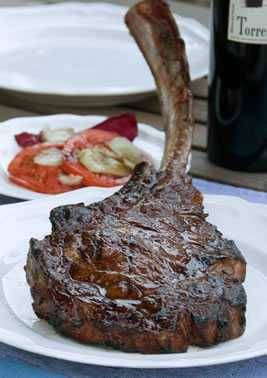
Cowboy ribeye, a.k.a.tomohawk ribeye
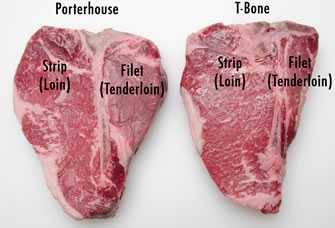
Two top dogs
Two of the most desirable steaks, and the largest, and the most expensive, are the T-Bone and porterhouse. Both contain a T-shaped bone with a section of strip (a.k.a. loin, a.k.a. longissimus dorsi) on one side and filet (a.k.a. tenderloin, a.k.a. psoas major) on the other. The main difference between them is the size of the filet. The T-bone comes mostly from the short loin and the filet must be a minimimum of 1/2″ wide below the backbone (bottom of the T). The porterhouse is from the sirloin, and the filet must be at least 1 1/4″ wide below the backbone. It can sometimes be as wide as 3″.
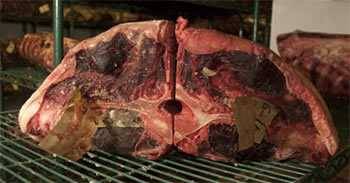
Two loin primals with two porterhouses facing us. At the bottom are the filets, on the top are the strips. If they were joined, they would be called a saddle of beef.

Bone-in strip steak.

Round/rump. This is the top of one of the rear legs and several cuts, mostly roasts, come from the round.
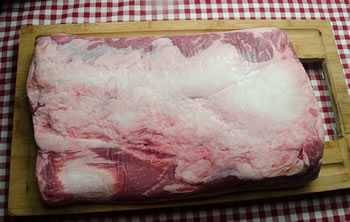
Navel is most often used for pastrami. Click here for a recipe for making pastrami.
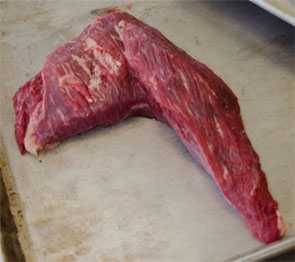
Tri-tip. Click for a recipe
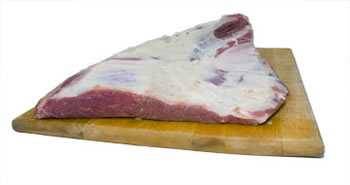
Whole packer brisket. Click here for my Texas Brisket recipe.
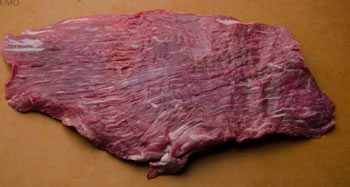


Skirt steak (fajita steak).

Las Vegas Strip Steak, from the chuck.

Top blade steak. From the chuck, the meat is flavorful and tender, but that strip of tendon is tough.
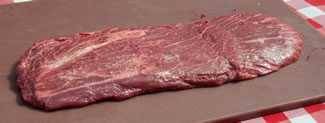
The flat iron is the muscle from above or below the tendon in the blade steak (previous picture). Below is the same piece after cooking.
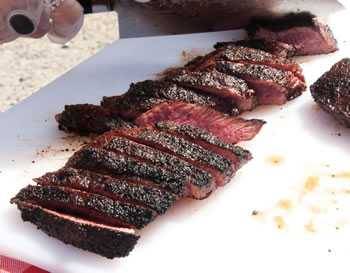

Whole tenderloin (top), butchered (bottom) into chateaubriand (center), two steaks, and stir fry meat.

Chateaubriand (from the center of the tenderloin).
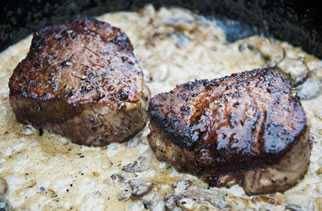
Filets Mignon from the chateaubriand, in a mushroom cream sauce.

Tongue with its skin (top), without (bottom)
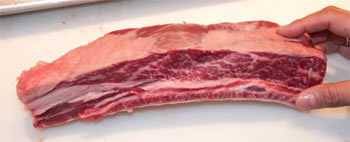
Beef short rib. Click the link for pictures of other rib cuts and for recipes.
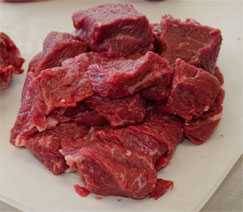
Beef cubes for kebabs or spiedies from bottom sirloin, but they can come from many cuts.
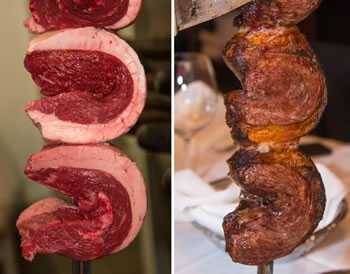
Coulotte is the top sirloin cap. It is a specialty of Brazilian steakhouses (photographed here at Fogo de Chao in Chicago) where it is rotisseried and served with its fat cap, considered a delicacy.
The Meat Buyer’s Guide: Beef, Lamb, Veal, Pork and Poultry by NAMI (North American Meat Institute) 8th Edition
8th Edition
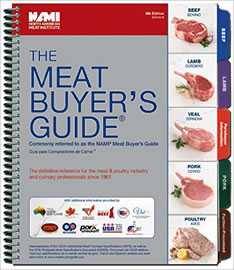
![]() The North American Meat Institute Meat Buyer’s Guide is the definitive reference on all the different cuts of meat, with charts, excellent photos, a glossary, and nutritional info. It is aimed at butchers, chefs, and ranchers, but a home chef can learn a lot. If you are really really into cooking, it is worthy of a spot on your bookshelf. Buy The Meat Buyers Guide
The North American Meat Institute Meat Buyer’s Guide is the definitive reference on all the different cuts of meat, with charts, excellent photos, a glossary, and nutritional info. It is aimed at butchers, chefs, and ranchers, but a home chef can learn a lot. If you are really really into cooking, it is worthy of a spot on your bookshelf. Buy The Meat Buyers Guide from Amazon.
University of Nebraska, Lincoln’s muscle study
The University of Nebraska, Lincoln has built a website devoted to bovine myology (muscle) studies. It has a complete list of all the muscles, 3D interactive photos, and videos of butchering.
Steak: One Man’s Search for the World’s Tastiest Piece of Beef

This book is great storytelling as we follow an inquisitive writer on his quest for a great steak. He travels the world learning about the history of bovine culture and breeds. Here he unearths a small herd of animals in France that are the closest relatives of the ancient ancestors of today’s cattle: Aurochs.
![]() “The herd numbered at least sixty, with a big bull, maybe 1,200 pounds, standing out front. By the looks of things, they were all competing in a who-can-grow-the- biggest-horns contest, and the big bull was in the lead, his own set being thicker and curving out wider than any of the others.
“The herd numbered at least sixty, with a big bull, maybe 1,200 pounds, standing out front. By the looks of things, they were all competing in a who-can-grow-the- biggest-horns contest, and the big bull was in the lead, his own set being thicker and curving out wider than any of the others.
“A blond eelstripe ran down his ample back, and he had more muscle hanging from one shoulder than could be harvested off my entire physique. The bull was walking heft. The bull was confidence wrapped in black leather.
“Convinced that we represented the same threat level as the flies buzzing around his head, the bull sauntered off to join three smaller cows. Safe, I thought, but not for long, because a younger male with smaller horns a male with something to prove„caught sight of me and set off my way. His pace was brisk, and as he approached he lowered his head and picked up speed. Horns pointed forward, he thrashed his head from side to side in the manner of a puppy destroying a slipper.”
He survives and goes on to discuss how the Nazi geneticists preserved the breed and how it tasted. Fascinating stuff. Buy Steak from Amazon.

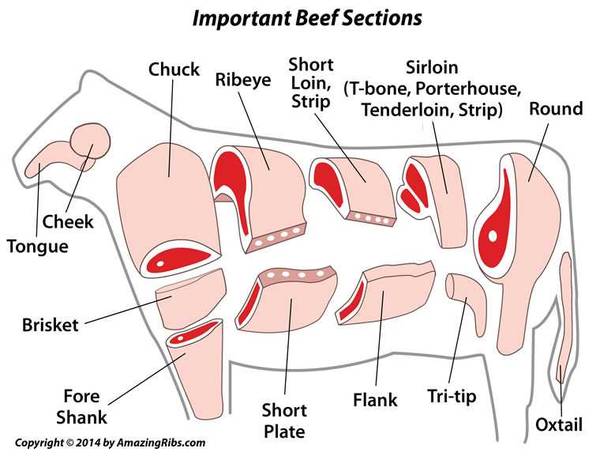

High quality websites are expensive to run. If you help us, we’ll pay you back bigtime with an ad-free experience and a lot of freebies!
Millions come to AmazingRibs.com every month for high quality tested recipes, tips on technique, science, mythbusting, product reviews, and inspiration. But it is expensive to run a website with more than 2,000 pages and we don’t have a big corporate partner to subsidize us.
Our most important source of sustenance is people who join our Pitmaster Club. But please don’t think of it as a donation. Members get MANY great benefits. We block all third-party ads, we give members free ebooks, magazines, interviews, webinars, more recipes, a monthly sweepstakes with prizes worth up to $2,000, discounts on products, and best of all a community of like-minded cooks free of flame wars. Click below to see all the benefits, take a free 30 day trial, and help keep this site alive.
Post comments and questions below
1) Please try the search box at the top of every page before you ask for help.
2) Try to post your question to the appropriate page.
3) Tell us everything we need to know to help such as the type of cooker and thermometer. Dial thermometers are often off by as much as 50°F so if you are not using a good digital thermometer we probably can’t help you with time and temp questions. Please read this article about thermometers.
4) If you are a member of the Pitmaster Club, your comments login is probably different.
5) Posts with links in them may not appear immediately.
Moderators